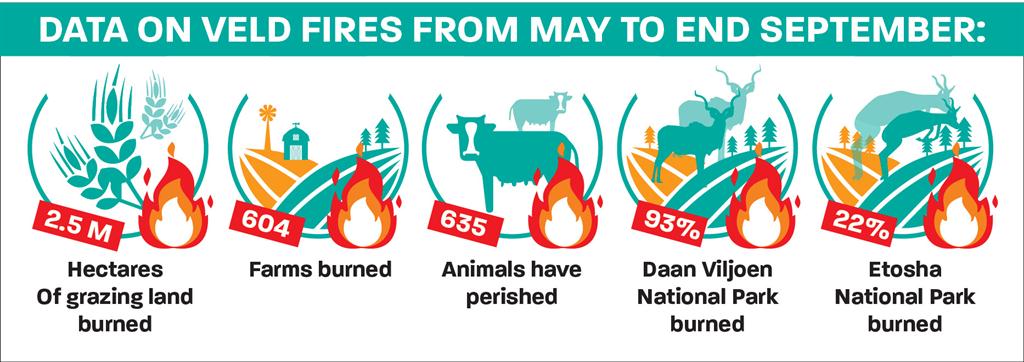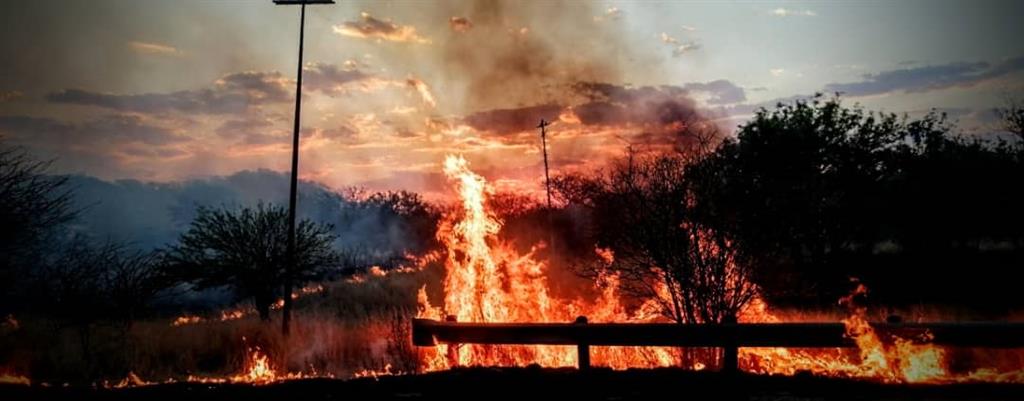Veld fires destroy 2.5 million hectares
ELLANIE SMIT
WINDHOEK
A massive 2.5 million hectares of grazing has been destroyed by veld fires since the start of Namibia’s fire season in May this year, while nearly 500 000 hectares have burned in Etosha National Park.
Environment minister Pohamba Shifeta told the National Assembly that this total included land on 604 farms and in many protected areas that have been affected by forest and veld fires.
It is estimated that approximately 635 animals have perished in fires outside protected areas.
Shifeta said the fires have resulted in the destruction of infrastructure and property, vast grazing areas and the loss of human and animal lives.
One of the regions particularly affected by veld fires was Khomas, where 93% of the Daan Viljoen National Park burned.
In the Ohangwena Region, about 10 500 hectares of grazing land burned from 17 to 19 September.
“Forest fires spread from the border with Kavango West and quickly into the eastern side of the Okongo quarantine area, destroying grazing camps.”
In the Omusati Region, an estimated 46 944 hectares burned in the constituencies of Okahao, Otamanzi and Tsandi from 15 to 20 September.
Meanwhile in the Oshana Region, an estimated 60 000 hectares of grassland in Uuvudhiya Constituency burned.
Shifeta said other severely affected regions included Hardap, specifically the Rehoboth District, Kavango East, Kavango West, Zambezi as well the Dordabis, Groot Aub and Oamites areas of Khomas.
In the Kunene Region, the Kamanjab, Outjo and Khorixas districts as well as a small portion of the Etosha National Park and farms to the south and east of the park suffered the impact of veld fires which also spread into the Otjozondjupa Region.
Etosha
Shifeta said the ministry in 2012 implemented a system of planned patch-mosaic burning and firebreaks in Etosha as a tool to support conservation.
“This involves the use of early burning and controlled burning of identified areas according to blocks for reduction of fuel load and to minimise hot fires spreading in the dry season.”
He said once a fire occurs inside a block, it is viewed as manageable because of the preventative measures in place through existing firebreaks.
An estimated 487 732 hectares, which accounts for approximately 22% of Etosha’s area, have been affected by forest and veld fires in 2021.
According to Shifeta this is an improvement compared to 60% of the total area burned in 2009 before the introduction of the patch-mosaic burning and firebreaks.
“In Etosha, it is notable that no mortalities of game nor injuries to humans and infrastructural damage have been recorded [this year],” said Shifeta.
Worse to come
The frequency, intensity and extent of veld fires were high because of the good rainfall received earlier in the year, which resulted in the accumulation of a high fuel load in many parts of the country.
“These occurrences are expected to become even more frequent and severe in the future in line with climate change predictions.”
The main causes of forest and veld fires have been charcoal production operations, mechanical appliances such as graders, recreational activities such as picnics, smokers, and local natural resource management-related activities such as hunting, honey production and thatch-grass harvesting.
Factors hampering effective fire prevention and control included locked farm gates, insufficient vehicles and equipment, lack of water sources in some areas and lack of cutlines and firebreaks in some areas.
[email protected]
WINDHOEK
A massive 2.5 million hectares of grazing has been destroyed by veld fires since the start of Namibia’s fire season in May this year, while nearly 500 000 hectares have burned in Etosha National Park.
Environment minister Pohamba Shifeta told the National Assembly that this total included land on 604 farms and in many protected areas that have been affected by forest and veld fires.
It is estimated that approximately 635 animals have perished in fires outside protected areas.
Shifeta said the fires have resulted in the destruction of infrastructure and property, vast grazing areas and the loss of human and animal lives.
One of the regions particularly affected by veld fires was Khomas, where 93% of the Daan Viljoen National Park burned.
In the Ohangwena Region, about 10 500 hectares of grazing land burned from 17 to 19 September.
“Forest fires spread from the border with Kavango West and quickly into the eastern side of the Okongo quarantine area, destroying grazing camps.”
In the Omusati Region, an estimated 46 944 hectares burned in the constituencies of Okahao, Otamanzi and Tsandi from 15 to 20 September.
Meanwhile in the Oshana Region, an estimated 60 000 hectares of grassland in Uuvudhiya Constituency burned.
Shifeta said other severely affected regions included Hardap, specifically the Rehoboth District, Kavango East, Kavango West, Zambezi as well the Dordabis, Groot Aub and Oamites areas of Khomas.
In the Kunene Region, the Kamanjab, Outjo and Khorixas districts as well as a small portion of the Etosha National Park and farms to the south and east of the park suffered the impact of veld fires which also spread into the Otjozondjupa Region.
Etosha
Shifeta said the ministry in 2012 implemented a system of planned patch-mosaic burning and firebreaks in Etosha as a tool to support conservation.
“This involves the use of early burning and controlled burning of identified areas according to blocks for reduction of fuel load and to minimise hot fires spreading in the dry season.”
He said once a fire occurs inside a block, it is viewed as manageable because of the preventative measures in place through existing firebreaks.
An estimated 487 732 hectares, which accounts for approximately 22% of Etosha’s area, have been affected by forest and veld fires in 2021.
According to Shifeta this is an improvement compared to 60% of the total area burned in 2009 before the introduction of the patch-mosaic burning and firebreaks.
“In Etosha, it is notable that no mortalities of game nor injuries to humans and infrastructural damage have been recorded [this year],” said Shifeta.
Worse to come
The frequency, intensity and extent of veld fires were high because of the good rainfall received earlier in the year, which resulted in the accumulation of a high fuel load in many parts of the country.
“These occurrences are expected to become even more frequent and severe in the future in line with climate change predictions.”
The main causes of forest and veld fires have been charcoal production operations, mechanical appliances such as graders, recreational activities such as picnics, smokers, and local natural resource management-related activities such as hunting, honey production and thatch-grass harvesting.
Factors hampering effective fire prevention and control included locked farm gates, insufficient vehicles and equipment, lack of water sources in some areas and lack of cutlines and firebreaks in some areas.
[email protected]






Comments
Namibian Sun
No comments have been left on this article